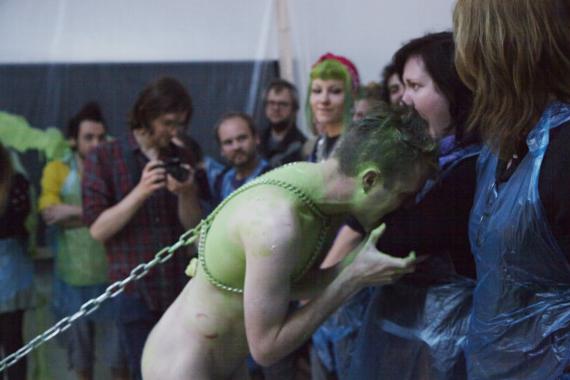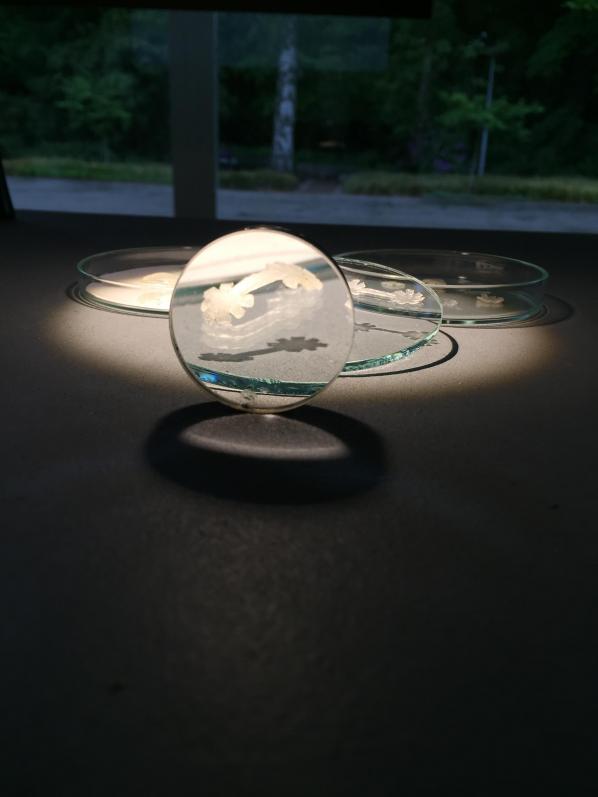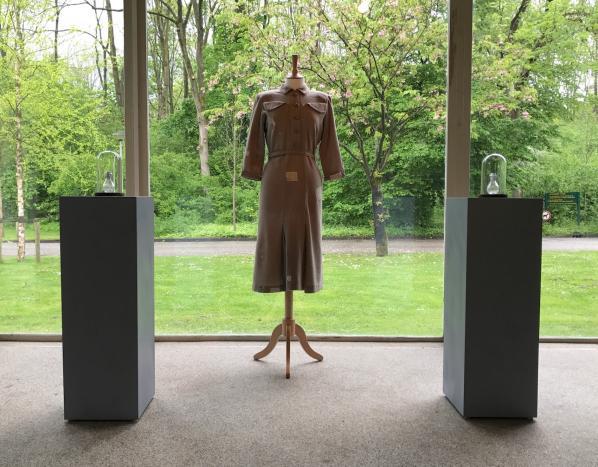



Feature image:
Trust Me, I’m an Artist: Jennifer Willet and Kira O’Reilly, Be-wildered, 2017. Photo: Nora S. Vaage
Trust Me, I’m an Artist is an exhibition organized in cooperation with the Waag Society at Zone2Source’s Het Glazen Huis in Amstelpark, in the outskirts of Amsterdam. It is a culmination of a Creative Europe-funded project, aiming to explore ethical complexities of artistic engagements with emerging (bio)technologies and medicine. The explorations in the exhibition have taken place through a play on the format of ‘the ethics committee’. In university contexts, particularly within medicine and the natural sciences, researchers need to submit their proposals to ethics committees to check whether their proposed projects comply with the relevant ethical guidelines, and to point to any issues the researchers hadn’t thought of. In the last couple of decades, as artists have increasingly taken part in institutional settings, even becoming residents in scientific labs, they too have sometimes been faced with these committees. The Trust Me, I’m an Artist project has included a handful of artists’ proposals to ethics committees, performed in front of an audience. Some of the exhibited pieces are documentation from those events, and are aesthetically somewhat unfulfilled. As thought-provocations, however, they still work.

Het Glazen Huis is, indeed, made mostly from glass, which creates the effect that the park outside enters into the exhibition room. For this exhibition it seems fitting, as the artworks deal, in various ways, with living things. While one of the pieces, Špela Petrič‘s Confronting Vegetal Otherness: Skotopoiesis, focuses directly on plants (more on that later), the only direct conversation with the green exterior is a pile of soil, generously run through with green specks of glitter, crowned by a striking headpiece topped with tall green feathers, which seems to mirror a fern plant of about the same height on the other side of the glass wall. The soil/hat construct is paired with a strange frock, constructed from old labcoats, but with frills and a cut resembling a 17th century garment, and far from white. The front and back of the coat is decked with transparent orbs, resembling snow globes. Each of them contains a different set of microbes, placed there through various acts of swabbing the environment or asking artist colleagues for donations in the form of mucus.
The frock and the soil concoction are the remnants of a performance by Jennifer Willet and Kira O’Reilly, which took place at the Waag Society the night before the exhibition opening. Willet was wearing the repurposed labcoats, O’Reilly the green headgear and a sparkling green dress inspired by drag and camp aesthetics. For much of the three-hour event, they talked about trust: what does it mean to trust? Do these artists trust themselves? O’Reilly stated that she is not sure she even values trust that much. They shared stories about their previous work, toasted with champagne, and interspersed their conversation, gradually, with elements of a “project proposal”.
O’Reilly, with Willet’s help, coated her arms in whisked eggs, as a base for green glitter. She showed examples of previous performances she had done using such glitter, often in the nude and sometimes involving fertilized chicken eggs. An hour into the performance, Willet revealed that her garment had been buried in soil at a conference, where people were encouraged to do stuff to the soil over the week: composting, urinating, etc, which explained the coat’s uneven, brownish tint. Only towards the end of the performance did she tell us that the globes were repurposed bowls made into “petri dishes”, filled with agar and ready to serve as a growth medium for various microorganisms. She then swabbed the jacket, swiping it onto the agar in one of the bowls, then swabbed O’Reilly’s nose. Willet proposes to wear another coat in the laboratory for a year, exposing it to various microorganisms, and to also wear it at home around her twin daughters, reflecting on how we large mammals serve in any case as carriers for all sorts of microbes. The ethics committee considered this a risky and unlikely aspiration, and did not think she would be allowed to go through with it. They did, however, encourage her to consult with them in developing her idea. A similar response was given to O’Reilly, who wants to cover a pine tree in Finland in glitter, reflecting on how her use of glitter is contributing to plastic pollution, and to work with a dead farmed salmon that she would get directly from a fish farm in Norway. At the end of the performance, O’Reilly unfolded a plastic sheet, spread three bags of soil onto the plastic, poured a bowl of glitter on top, and mixed it with her hands in a languid, beautiful way. She fetched a gutted whole salmon from a fridge, sprinkling glitter on it as well. Both of them, thus, did part of what they are proposing to do for their project already during the “ethics consultation”, challenging the format. But they reflected at the close that the opportunity to think extensively on the ethics of their ideas was rewarding and important.
Martin O’Brien‘s Taste of Flesh – Bite Me I’m Yours is also documentation of a performance, which he did in London at Space c/o the White Building, in April 2015. His performance was an exploration of endurance, pain, and the overstepping of intimate boundaries. Working with his own body, O’Brien seems to have embraced the facts of living with a genetic disorder, Cystic Fibrosis, to the full. The disease causes him to produce a lot of mucus, and be short of breath.
Over a number of hours, he did a series of actions; chaining himself, biting people, being bitten, coughing up mucus, crawling around in a way that was inspired by the zombie as metaphor for being sick. He played with the fear that interaction will result in contagion, and with S&M paraphernalia and the limits between pain and pleasure. In the exhibition we see the performance on a projection taking up a whole wall, and five small, parallel video screens showing different parts of the performance. Remnants of the paraphernalia he used are exhibited on a plinth. The films in part convey the intensity and some-time repulsion that the performance must have inspired.

Petrič’s work Skotopoiesis is less explicit, and perhaps less provocative to most. In the exhibition, we see a photograph of a field of cress, with the outline of a human shadow making the center cress paler than the rest. By standing in front of the field, preventing the light from falling onto the same spot for 19 hours a day, three days on end, she created a visible imprint of her body, through cress that grew to be longer and paler than the neighboring plants that got direct sunlight.
Plants do not follow same rules of agency as animals. We cannot easily relate to them, although some, such as trees, seem to have more presence and individuality. Grass, on the other hand, is impossible to think of as single entity. Often, as part of the ethics procedure, researchers are asked if they can use plants rather than animals, as current perceptions of what is ethical tend to exclude plants from our ethical consideration. Petrič wanted to challenge the committee with something anti-spectacular, where it would be difficult to see ethical issues. Through existing with plants, trying to conform to their timescale and mode of existence, but also modifying them through her very presence, she entered into a pensive engagement not just with the plants themselves, but with the ethics of our coexistence with them. This seems quite a timely, as recent studies show plants to have more sensations, reactions, and even abilities of communication, than has previously been thought. Given this, our disregard for the life of plants may be seen as a great ethical challenge.
Artist Gina Czarnecki and scientist John Hunt, in the piece Heirloom, created masks in the shape of Czarnecki’s two daughters’ faces, grown from their skin cells over glass casts. This, too, is shown on several video screens, as documentation of the actual installation of the bioreactors in which the masks were grown. The artist wanted to preserve her daughters’ youthful likenesses, and the idea led to the development of a new, simple set-up for three-dimensional cell growth. One of the tricky ethical issues here is that of the ownership of a child’s cells. As the girls’ parent, Czarnecki could herself consent to using their cells in this way. They were happy to participate at the time, but does this kind of artistic, experimental use constitute “informed consent”? At the opening, Czarnecki observed that her daughters, moving into their mid-teens in the three or so years since their skin samples were taken, had become less comfortable with being on display in this way.
The videos show fascinating glimpses of the process, footage of the masks inside the bioreactors, flashing shots of the daughters’ faces, and narrations by the key actors. At one point in the video, Hunt describes how he and two of his fellow researchers both came into the lab because they were worried about the skin cells being contaminated. Without having anything to do there, they sat together and watched over them. A rare admittance of the personal bonds that can be formed with cell cultures, and reasons for action that are far from the rational.

Howard Boland‘s Cellular Propeller is represented in the exhibition through a few sculptural elements and photos. The project started as part of his long-time engagement with synthetic biology, and his ambition was to work with living, moving cells, attached to inorganic structures, to play with the old idea that “If it moves, it is alive”. Originally he hoped to use heart cells from new-born rats, but this proved difficult. Instead, he ended up using his own sperm cells, which are much more easily available, and share the ability to move. He created coin-sized, wheel-shaped plastic scaffolds that the sperm cells can ideally attach to, serving as “propellers” to literally,move the human cells, although this does not happen in a predictable way. In the exhibition, we saw reproduced the little plastic scaffolds, but not with the cells “in action”.
With the change from heart cells to sperm, the connotations of the piece changed slightly; while the question of “what is living” remains, reproduction, birth and movement still being central to the piece, the use of sperm also brings in ideas about pleasure and the surplus production of cells through recreational sex. Through repurposing sperm cells for the mechanical task of moving these wheels, Boland shifts the discussion towards life without the basic “meaning” that reproduction conveys.
“Controlled Commodity” by Anna Dumitriu features a dress from 1941, also exhibited on a headless mannequin, and mended with patches containing gene-edited E. coli bacteria. An example of wartime austerity, the dress is CC41 – controlled commodity 41. Dumitriu stresses the fact that 1941 was the first year that penicillin was used, and unlike clothing, this was not a controlled commodity. Overuse of antibiotics over many years has led to the current crisis, with more and more bacteria becoming resistant to the antibiotics we commonly use.

Through participation in the Future and Emerging Art and Technology program, Dumitriu was an artist in residence in an Israeli lab, and worked with the much-hyped, much-discussed CRISPR-Cas9 technology. The use of CRISPR for gene editing is currently being presented as a much easier way to insert or remove genetic information. In this case, Dumitriu used it to remove a gene for antibiotics resistance.
When she had to create a repair fragment to patch the bacteria back together, she used the phrase ‘make do and mend’, an explicit reference to WWII history. Dumitriu grew the CRISPRed bacteria on silk, sterilized them, and sewed the E. coli patches onto the (somewhat moth-eaten) dress. In addition to the dress, she is displaying the plasmid created using CRISPR in a little glass vase, only covered with aluminum foil – and without having asked permission. In an identical glass vessel, little paper circles contain all the antibiotics in commercial use.
The piece is rich, complex, and daring. In editing the genome of E. coli bacteria to remove an ampicillin antibiotic resistance gene, Dumitriu is proposing a potential solution to the pervasive problem of antibiotics resistance, which might also be ethically problematic: such suggested solutions being “around the corner” might lead to less focus on discovering new antibiotics, or the sense that continued over-use can be maintained. Also, her insistence on exhibiting plasmids in the gallery is not high-risk (as far as we know, plasmids need some sort of shock effect to be taken up by bacteria), but it does seem a somewhat unnecessary exposure. Dumitriu’s CRISPR work will be discussed in a Trust Me… event at the British Science Festival in Brighton in September.
Open Care – Inheritance, by Erich Berger and Mari Keto, imagines a personal responsibility for nuclear waste, in the form of radioactive family jewellery that goes from generation to generation, in the hope that you might one day wear it. The jewellery is kept in a radiation-proof container, and for each generation that takes over its care, it can be tested to see if the radioactivity has gone down to a safe level, so that “the jewellery can finally be brought into use and fulfill its promise of wealth and identity or if it has to be stored away until the next generation” (quote from the exhibition catalogue). The jewellery box and low-tech tools to check its radioactivity are exhibited behind a glass wall. This thought experiment suggests that the unimaginably long timespans that it takes for radioactivity to subsist can be broken down into spans of time that we can relate to. The personal nature of such family jewellery creates an emotional narrative of very personal responsibility for the waste we produce.
The artistic license seems to be to challenge, stretch, and provoke, and indeed, the artworks in this exhibition both challenge and stretch our views on what responsibility means. So, can we trust what these artists are up to? One never knows, but through engaging in these extended conversations with the public and hand-picked committees, they do give us new grounds for reflection on ethics, trust, and responsibility in science, in society at large, and in art.
Note: I saw this exhibition during the opening, and some elements were still not up and running.